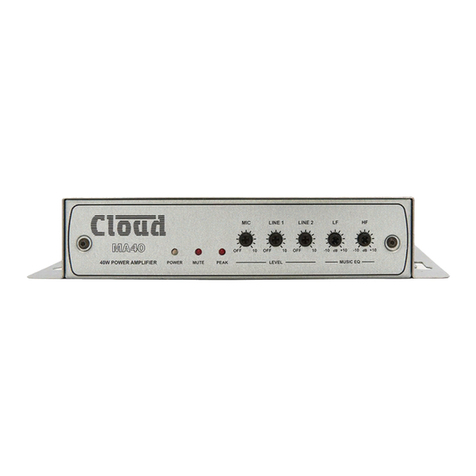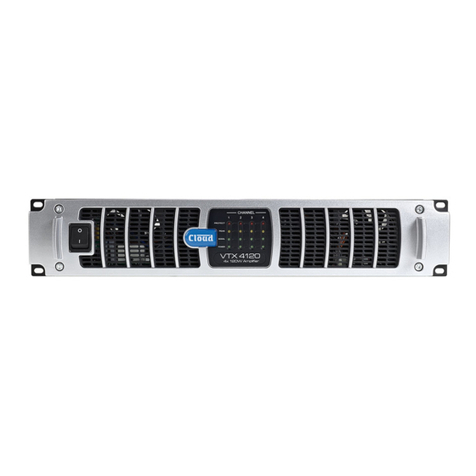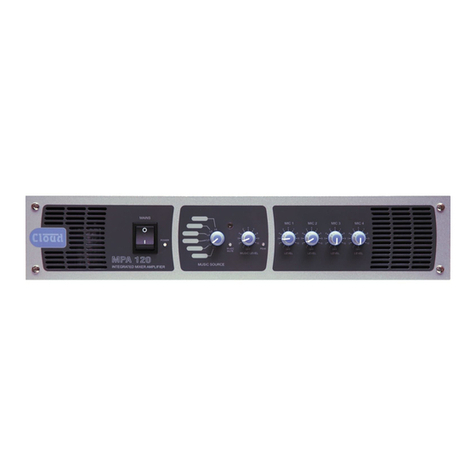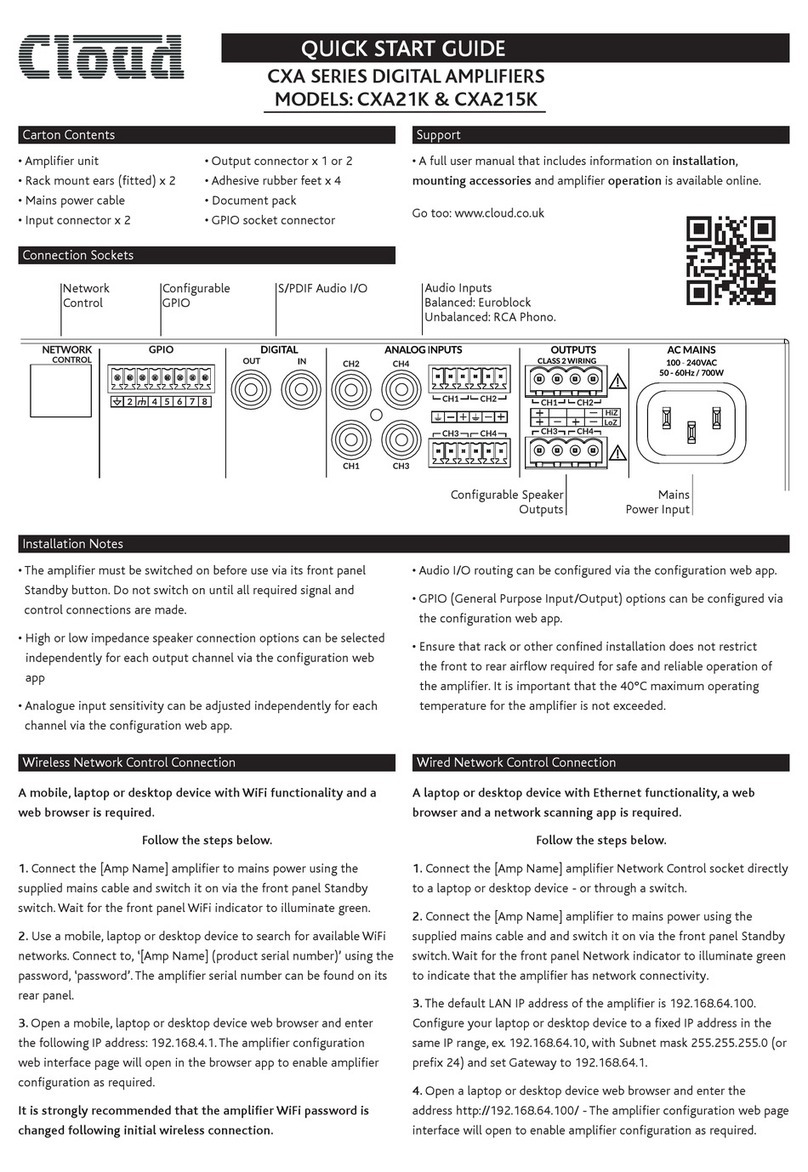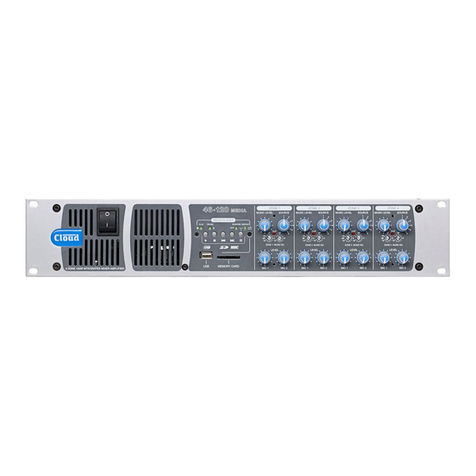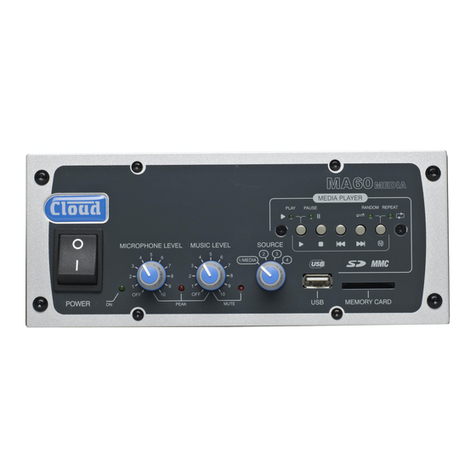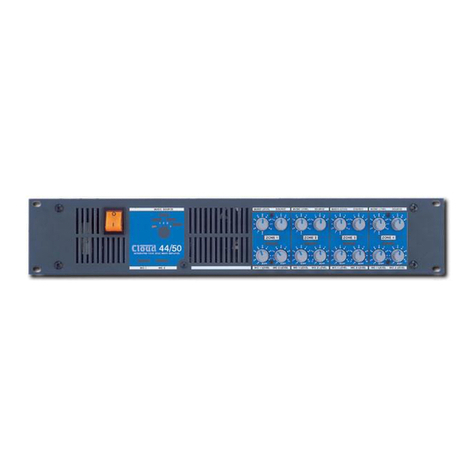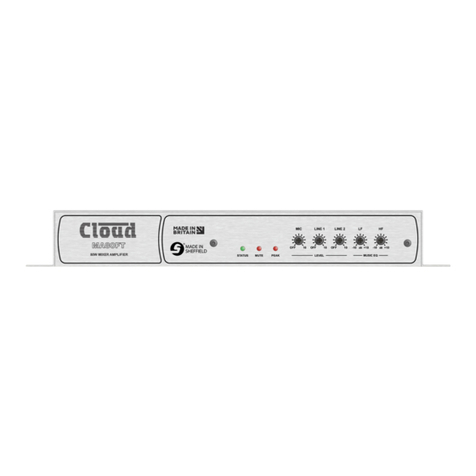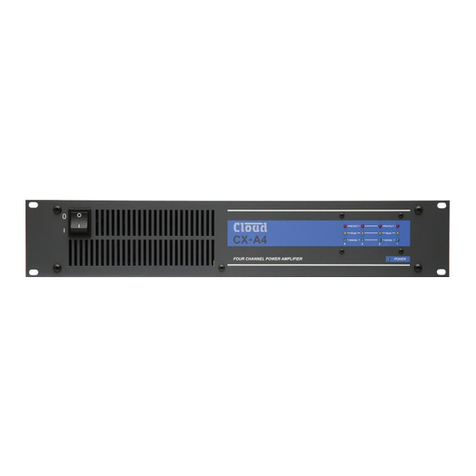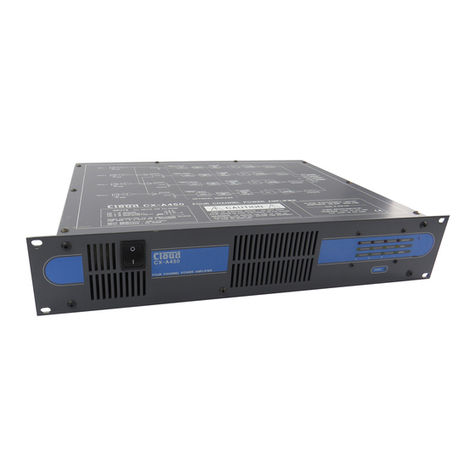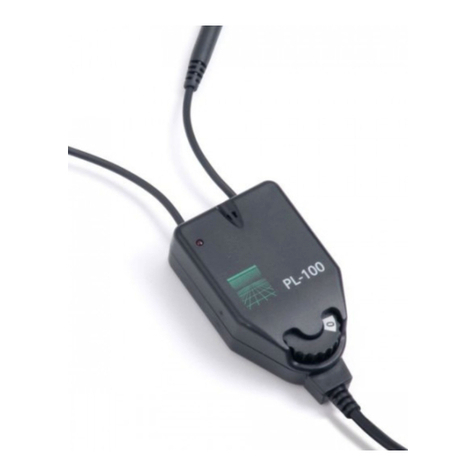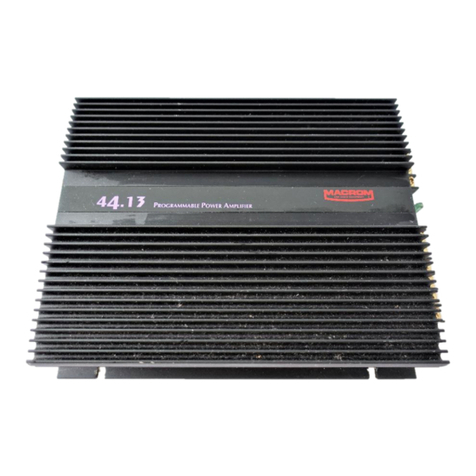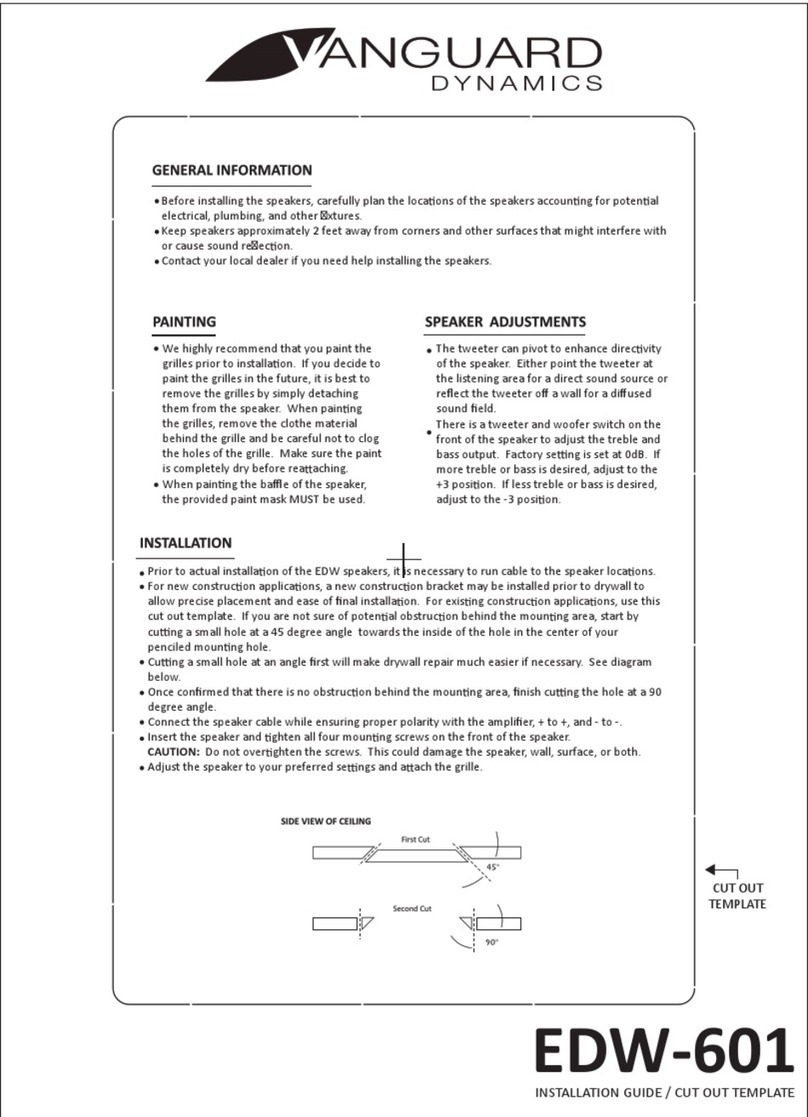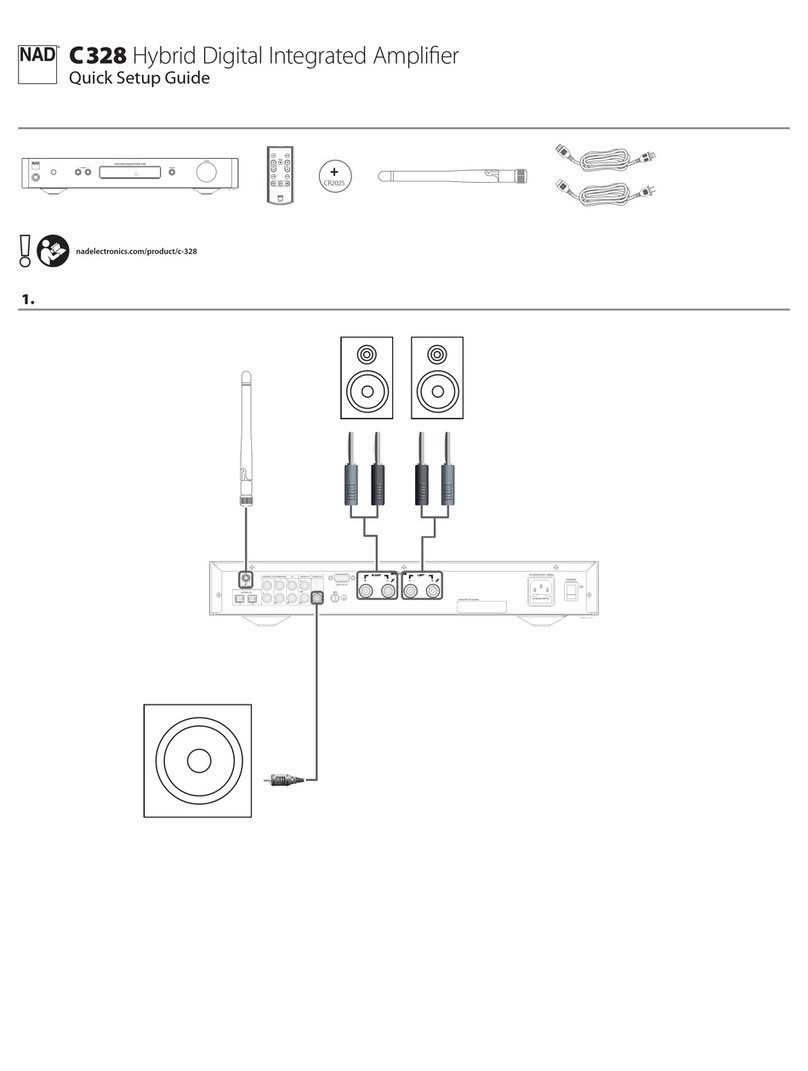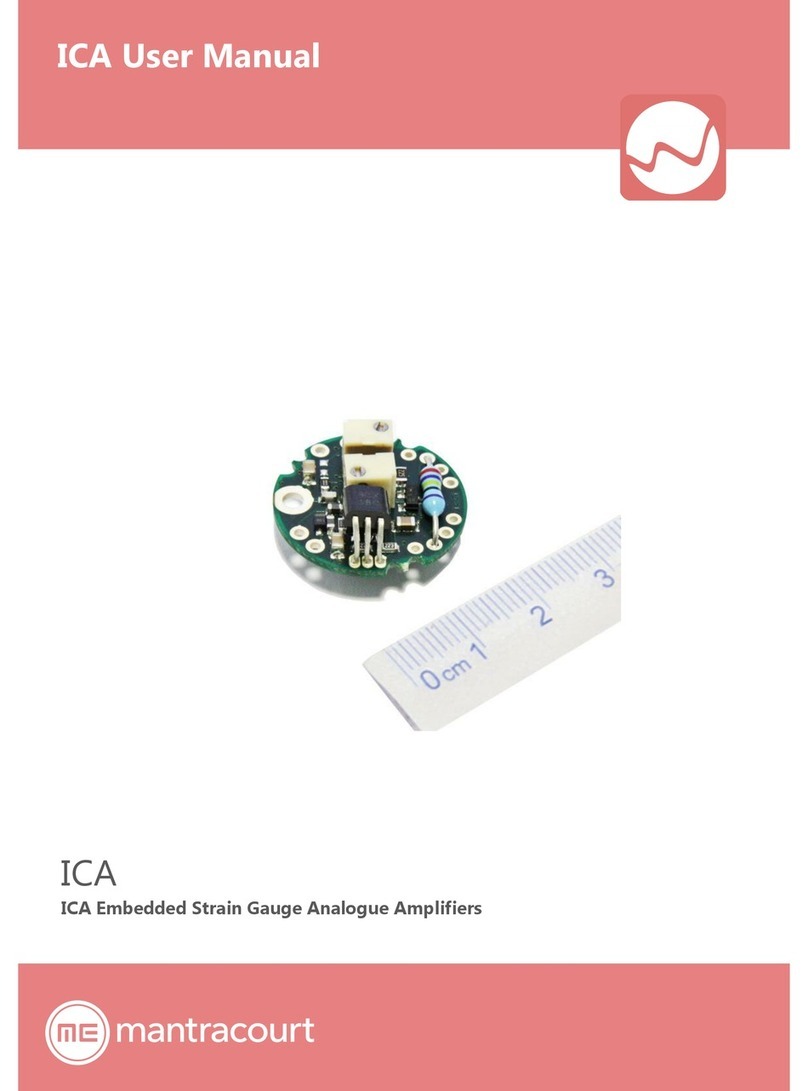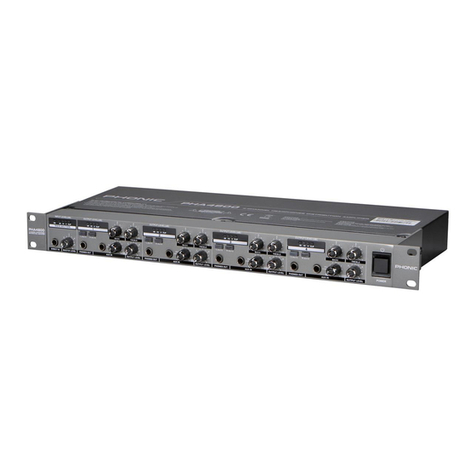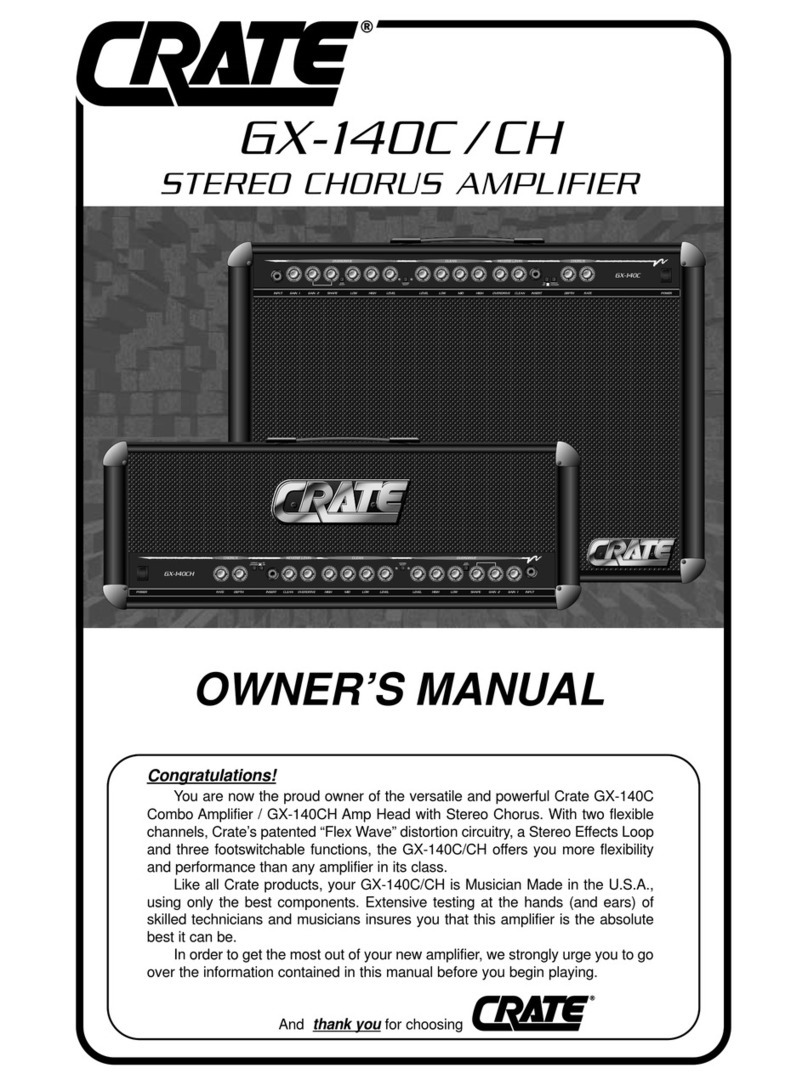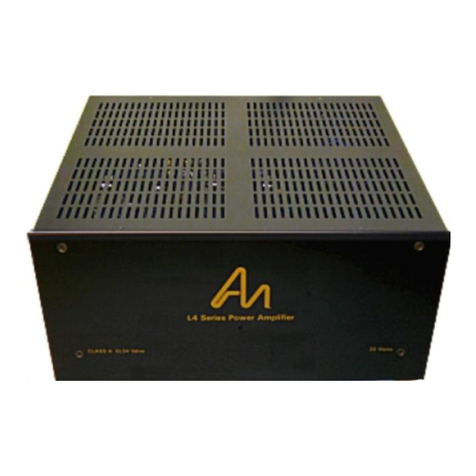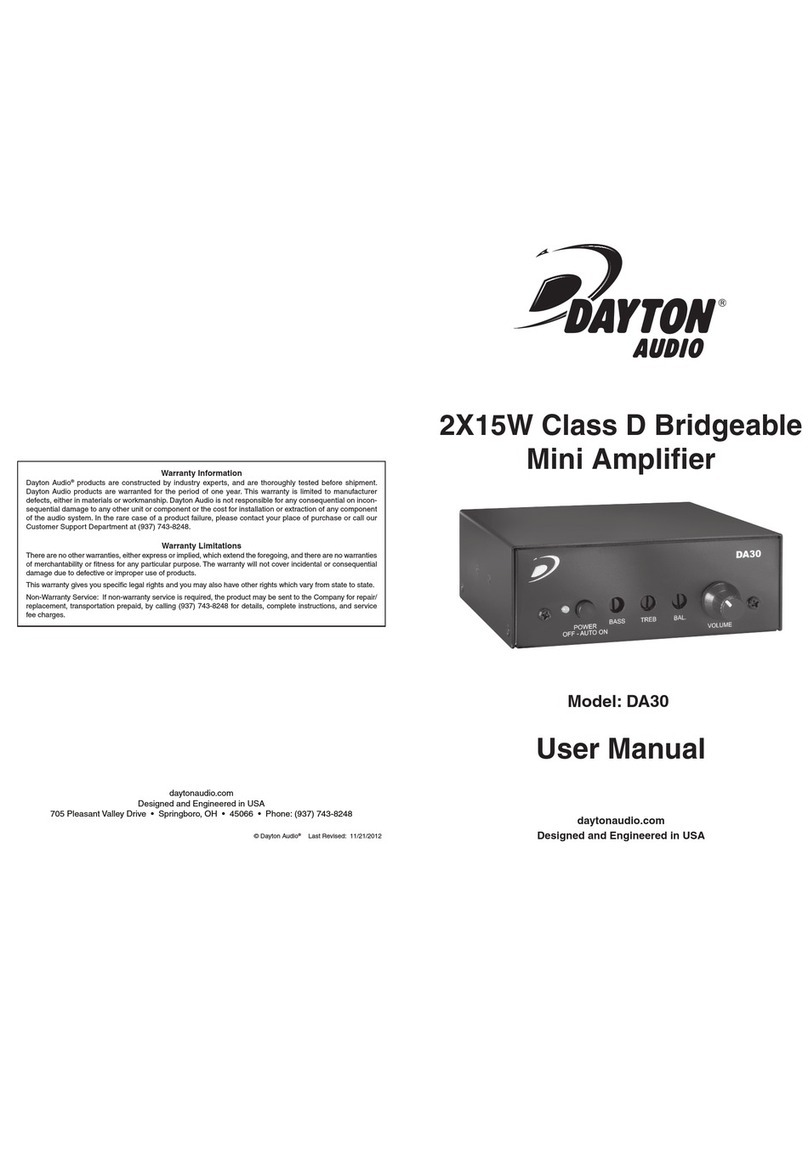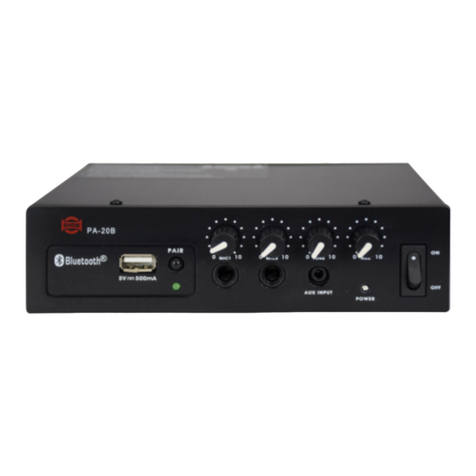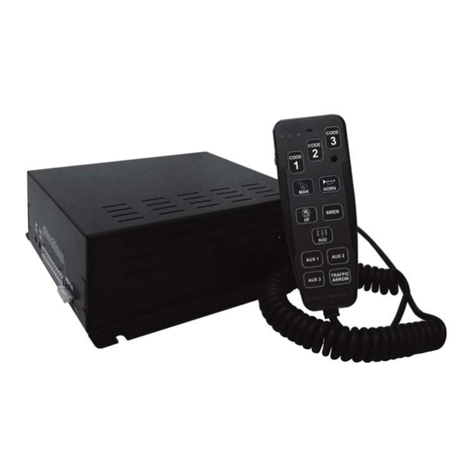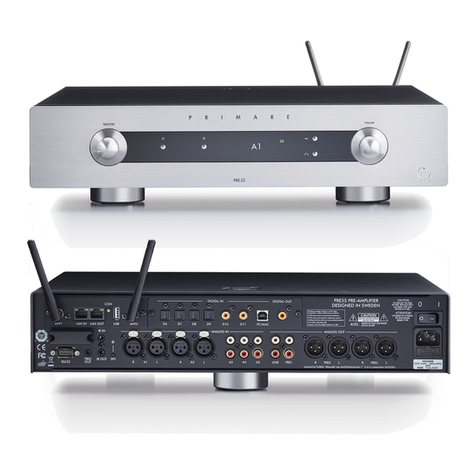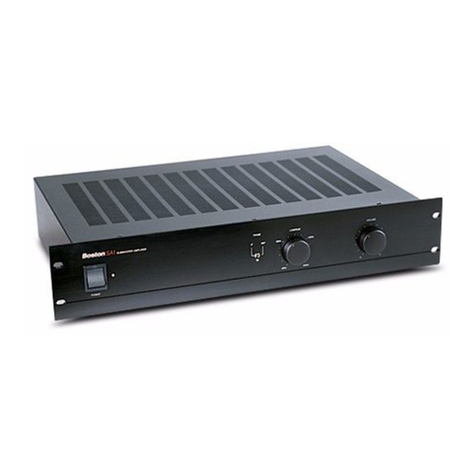Cloud Contractor Series Installation instructions

VMA Series Installation Guide V1.0
VMA SERIES MIXER-AMPLIFIERS
MODELS VMA120 AND VMA240
CONTRACTOR SERIES
INSTALLATION GUIDE

VMA Series Installation Guide V1.02
WARNING:
To reduce the risk of re or electric shock, do not expose this appliance to rain or moisture.
CAUTION:
Use of controls or adjustments or performance of procedures other than those specied may result in hazardous radiation
exposure.
WARNING: SHOCK HAZARD – DO NOT OPEN
AVIS: RISQUE DE CHOC ELECTRIQUE – NE PAS OUVRIR
The lightning ash with the arrowhead symbol within an equilateral
triangle, is intended to alert you to the presence of uninsulated
dangerous voltages within the product’s enclosure that may be of
sufcient magnitude to constitute a risk of electric shock.
The exclamation point within an equilateral triangle is intended to
alert the user to the presence of important operating and maintenance
(servicing) instructions in the literature accompanying the appliance.

VMA Series Installation Guide V1.0 3
IMPORTANT SAFETY INSTRUCTIONS
1. Read these Instructions.
2. Keep these Instructions.
3. Heed all Warnings.
4. Follow all Instructions.
5. Do not use this apparatus near water.
6. Clean only with a dry cloth.
7. Do not block any ventilation openings. Install in accordance with the manufacturer’s instructions.
8. Do not install near any heat sources such as radiators, heat registers, stoves or other apparatus (including ampliers) that
produce heat.
9. Do not defeat the safety purpose of the polarized or grounding - type plug. A polarized plug has two blades with one wider
than the other. A grounding type plug has two blades and a third grounding prong. The wide blade or the third prong are
provided for your safety. When the provided plug does not t into your outlet, consult an electrician for replacement of
the obsolete outlet.
10. Protect the power cord from being walked on or pinched particularly at plugs, convenience receptacles, and the point
where they exit from the apparatus.
11. Only use attachments/accessories specied by the manufacturer.
12. Use only with the cart, stand, tripod, bracket or table specied by the manufacturer or sold with the apparatus,
when a cart is used, use caution when moving the cart/apparatus combination to avoid injury from tip-over.
13. Unplug this apparatus during lightning storms or when unused for long periods of time.
14. Refer all servicing to qualied service personnel. Servicing is required when the apparatus has been damaged in any way,
such as power-supply cord or plug is damaged, liquid has been spilled or objects have fallen into the apparatus, the apparatus
has been exposed to rain or moisture, does not operate normally, or has been dropped.
Do not expose the apparatus to dripping or splashing, and ensure that no objects lled with water, such as vases, are
placed on the apparatus.
L’appareil ne doit être exposé aux écoulements ou aux éclaboussures et aucun objet ne contenant de liquide, tel
qu’un vase, ne doit être placé sur l’appareil.
The mains plug is used as the disconnect device and it should remain readily accessible during intended use. In order
to isolate the apparatus from the mains, the mains plug should be completely removed form the mains outlet socket.
Le prise du secteur ne doit pas être obstruée ou doit être facilement accessible pendant son utilisation. Pour être
complètement déconnnecté de l’alimentation d’entrée, la prise doit être débranchée du secteur.
This apparatus is of Class 1 construction and must only be connected to a mains outlet socket with a protective
earthing connection.
Terminals marked with the symbol may use Class 2 Wiring, but voltages at these terminals may be of sufcient
magnitude to constitute a risk of electric shock. The external wiring connected to these terminals requires
installation by an instructed person or the use of pre-made leads or cords.

VMA Series Installation Guide V1.04
Safety Information
Safety Notes regarding Installation
• Do not expose the unit to water or moisture.
• Do not expose the unit to naked ames.
• Do not block or restrict any air vent.
• Do not operate the unit in ambient temperatures above 35°C
• Do not touch any part or terminal carrying the hazardous live symbol while power is supplied to the unit.
• Do not perform any internal adjustments unless you are qualied to do so and fully understand the hazards associated with
mains-operated equipment.
• The unit has no user-serviceable parts. Refer servicing to qualied service personnel.
• If the moulded plug is cut off the AC power lead for any reason, the discarded plug is a potential hazard and should be
disposed of in a responsible manner.
Conformities
This product conforms to the following European EMC Standards:
EN 55032:2015 -Emissions
EN 55035:2017 -RF Immunity
EN 61000-3-3:2013 -Supply voltage tolerance
EN 61000-3-2:2018 -Harmonics
EN 62368-1:2018 -Electrical safety
Safety Considerations and Information
Cloud VMA Series mixer-ampliers must be earthed. Ensure that the mains power supply provides an effective earth connection
using a three-wire termination.
Caution – High Voltage
Do not touch any part or terminal carrying the hazardous live symbol while power is applied to the unit. Terminals to which
the hazardous live symbol refers require installation by a qualied person.
Caution – Mains Fuse
Mains over-current protection is provided by the user-replaceable fuse in the IEC receptacle. Only replace this fuse with one of
an identical type and rating:
230 V versions 115 V versions
Fuse type T2AH time-delay T4AH time-delay
Fuse size 5 mm dia x 20 mm
Fuse rating 2 A 4 A
Caution – Servicing
The unit contains no user-serviceable parts. Refer servicing to qualied personnel. Do not perform servicing unless you are
qualied to do so. Disconnect the power cable from the unit before removing the top panel and do not make any internal
adjustments with the unit switched on. Only reassemble the unit using bolts/screws identical to the original parts.

VMA Series Installation Guide V1.0 5
Important
Read this before connecting the amplier to AC mains
VMA Series mixer-ampliers are pre-congured at the factory to operate on either a 115 V or a 230 V AC mains
supply. Before applying power to the unit, please check the rear panel to ensure that the version you have is
correctly set for your local supply voltage.
The MAINSVOLTAGE SELECTOR switch on the rear panel will show either 230V or 115V, as shown below.
The warning sticker above the switch will conrm the factory setting.
115
115V ±10%
POWER 40-60 Hz
MAX: 250 W
CAUTION:
REPLACE WITH SAME TYPE T8AH 250V FUSE
ATTENTION:
UTILIZER UN FUSIBLE DE RECHARGE DE
MEME TYPE DE T8AH 250V.
WARNING!
THIS PRODUCT IS FACTORY CONFIGURED
FOR 115V SUPPLY. BEFORE POWERING,
VERIFY THAT THIS MATCHES THE SUPPLY
VOLTAGE OF THE INSTALLTION.
VMA240
115
115V ±10%
POWER 40-60 Hz
MAX: 250 W
CAUTION:
REPLACE WITH SAME TYPE T8AH 250V FUSE
ATTENTION:
UTILIZER UN FUSIBLE DE RECHARGE DE
MEME TYPE DE T8AH 250V.
WARNING!
THIS PRODUCT IS FACTORY CONFIGURED
FOR 115V SUPPLY. BEFORE POWERING,
VERIFY THAT THIS MATCHES THE SUPPLY
VOLTAGE OF THE INSTALLTION.
VMA240
DO NOT CONNECT YOUR VA SERIES AMPLIFIER TO AN AC SUPPLY
WITHOUT FIRST VERIFYING THE VOLTAGE SETTING.
Introduction
The Cloud VMA120 and VMA240 are cost-effective mixer-ampliers for use in all types of commercial premises, such as pubs,
bars, hotels and ofces. They have been designed to be as simple to install and operate as possible, yet retain a useful range of
conguration options.
The units are mono power ampliers combined with a simple mixer stage. The two models are identical in terms of facilities,
and differ only in the maximum power output available – 120 W or 240 W respectively. They may be used to drive either low-
impedance loudspeakers directly (4 ohms minimum) or 25/70/100 V-line loudspeaker distribution systems. The two different
types of speaker system cannot be driven simultaneously.
The mixer stage has four stereo line inputs, including one in the form of a 3.5 mm jack socket on the front panel to permit
the easy connection of laptops, tablets and similar devices. There are also two microphone inputs. Front panel switches allow
the mics to have priority over music sources, and also for one line input to have priority over the others: this will be useful for
connecting a message store, for example. All user controls are on the front panel.
The rear panel has connections for a music mute control input which can be used to mute all music sources in an emergency,
and also a balanced auxiliary output to allow additional power ampliers to be slaved.
The VMA120/240 have several internal PCB jumpers which may be moved to recongure certain aspects of the unit’s operation.
These include enabling microphone phantom power and LF ltering, selection of priority triggers as pre or post the level
controls, and a selectable hi-pass lter for use with 25/70/100 V-line systems. See “Table of internal jumpers” on page 10 for
a full list of functions.

VMA Series Installation Guide V1.06
Rear panel – connections and controls
257 6 3 8
2 4
1
VMA 120
1. LINE 1, LINE 2 and LINE 3 – stereo line inputs on phono (RCA) connectors. Connect music sources (CD players, PCs,
satellite/TV receivers, etc.) here; the stereo signals are summed internally to mono. Each input has an associated GAIN
control with a range of 20 dB; adjust these so that each music source connected has approximately the same volume.
LINE 1 may be set to take priority over the other two – see [4] on front panel.
2. MIC1 IN and MIC2 IN – microphone inputs. Both inputs are balanced: MIC1 IN uses a 3-pin, 3.5 mm-pitch screw-terminal
connector: see rear panel for pinout; a mating connector is supplied. MIC2 IN uses a ¼” (6.35 mm) 3-pole TRS jack socket
(T=hot, R=cold, S=screen). Each mic input has an associated GAIN control with a range of 40 dB: these should be adjusted
so that the front panel MIC LEVEL controls can be turned to maximum without distortion or feedback occurring. 15 V
phantom power is available at either/both mic inputs if needed, by moving internal jumpers – see “Table of internal jumpers”
on page 10. The mic inputs may be set to take priority over the music sources – see [8] on front panel.
NOTE
The two output connectors ([3] and [4] below) have a single removable safety cover
which should be removed (two screws) to make the connections, and then retted.
3. LOW IMPEDANCE output – amplier output for driving low-impedance loudspeakers. The connector type is a 2-pin 5
mm-pitch screw-terminal type: a mating connector is supplied. If connecting multiple loudspeakers, installers must ensure
that the total impedance is not less than 4 ohms.
4. C.V. OUTPUTS – amplier output for driving 25/70/100 V-line loudspeaker distribution systems. The connector type is a
4-pin 5 mm-pitch screw-terminal type: a mating connector is supplied. Only make connections to the 0V terminal and one
other, depending on the voltage rating of the system in use. A 70 Hz high-pass lter limits the LF content to reduce the
possibility of transformer core saturation: this lter may be bypassed if wished by moving an internal jumper, see “Table of
internal jumpers” on page 10.
Do not attempt to make connections to this output while the mixer-amplier is powered, as there may be voltages
present at the terminals of sufcient magnitude to cause an electric shock.

VMA Series Installation Guide V1.0 7
IMPORTANT
Do not attempt to use both the LOW IMPEDANCE output and the C.V. OUTPUTS at the same time.
Failure to observe this restriction is likely to result in permanent damage to the amplier power stage.
5. AUX OUT – a balanced output on a 3-pin, 3.5 mm-pitch screw-terminal connector. See rear panel for pinout; a mating
connector is supplied. This connector carries a line level signal derived from the output of the mixer stage and is suitable
for connecting to the inputs of additional power ampliers. The output is a mix of both music and microphone signals and
will be affected by any priority settings. All the front panel MICROPHONES and MUSIC controls will affect the signal at
the auxiliary output, but it is not affected by any of the MASTER controls..
6. MUSIC MUTE – a 2-pin, 5 mm-pitch screw-terminal connector. Shorting the pins together will mute the music content
of the mixer-amplier’s outputs, including the Auxiliary Output, and Line Input 1 if Line 1 Priority is selected and currently
active (see [4] on front panel). Microphones will remain active. Connecting MUSIC MUTE to a suitable pair of normally-
open contacts on a re alarm panel (or similar system) may aid compliance with local emergency regulations. If it is
desirable to mute the microphone inputs as well as the music signal, an internal jumper can be moved to permit this: see
“Table of internal jumpers” on page 10.
7. POWER INPUT – connect AC mains here using the cable supplied, which will have a mains plug suitable for your territory.
Only use a 3-wire connection, to ensure the unit is earthed (grounded). The POWER INPUT connector incorporates a
fuse holder – see page 4 for fuse data.
8. Fan – the VMA120 and VMA240 are forced-air cooled. Ensure there is adequate space at the rear of the chassis for airow
and that the fan is not obstructed. The internal protection circuitry incorporates temperature sensing, and the mixer-
amplier will shut down in the event of overheating.

VMA Series Installation Guide V1.08
Internal Settings
WARNING – DANGER
Changing the internal settings requires to open the unit. Prior to opening the unit, the unit shall be disconnected
from any AC supply. Any work on an open unit shall be expedited only by qualied, certied personnel.
Output conguration (hi-voltage/low-impedance)
The output stage of a VMA Series mixer-amplier may be congured EITHER for driving low impedance loudspeakers (4 ohms
minimum), or for driving 25/70/100 V-line loudspeaker systems.
Units are shipped with the output congured for driving 25/70/100 V-line systems. To convert it for low-impedance operation:
• Disconnect the mixer-amplier from the AC mains supply.
• Remove the top lid.
• The toroidal output transformer is the larger of the two:
VMA120/240
Output
transformer
Power
transformer
• The transformer’s windings terminate in a pair of in-line, multipin connectors. The primary winding (red and black wires)
terminates in a 2-pin female connector, and the secondary winding (blue, white, yellow and purple wires) terminates in a
4-pin female connector. Unplug the 2-pin connector from its header on the vertical PCB mounted on the heatsink at the
left-hand side of the amplier (viewed from the front). See diagram below:
Pri. Sec.
100 V
70 V
COM
Red
Black
White
Purple
Blue
Yellow
25 V
F
F
M
FM
Red
Black
To Lo-Z output
connector
To 100/70/25 V-line
output connector
Connection for
Lo-Z operation
Connection for
100/70/25 V-line
operation
Power amplifier
output - 2-pin
header on heat
sink PCB
• Identify the red and black pair of wires from the low-Z output terminals: these also terminate in a 2-pin female connector,
currently unplugged. Plug this into the 2-pin header connector vacated in the previous step.
• Locate jumper J100 on the PCB mounted on the rear panel. This has two positions, ON and OFF. At shipment, it will be
set to ON, placing the 70 Hz high-pass lter in circuit, which is the correct setting when the mixer-amplier is used with
25/70/100 V-line systems. Using a pair of long-nosed pliers, move J100 to its OFF position.
• Replace the top lid.
If at any time it is necessary to convert the low-impedance output back to 25/70/100 V-line operation, reverse the above
procedure, reconnecting the amplier output to the transformer primary.

VMA Series Installation Guide V1.0 9
Front panel – connections and controls
187 3 9 1213
24
5 11
6 10
VMA 120
1. MUSIC SOURCE – rotary switch, selects a music source from LINE 1, LINE 2, LINE 3 or the adjacent AUX input [2].
2. AUX – 3.5 mm jack socket for the temporary connection of laptops, tablets, smartphones, etc. The socket is a TRS type,
wired T= left, R = right, S = screen. This input has a xed sensitivity of 0 dBu: match the volume of a source connected here
against the other music sources by adjusting the output level of the connected device.
3. MUSIC LEVEL – sets the volume of the selected music source.
4. LINE 1 PRI – selecting this option gives a source connected to LINE 1 automatic priority over the currently selected
music source. This can be useful if an emergency message system, jukebox or similar source needs to form part of the audio
system. The priority is triggered by the detection of a signal at Line 1 input; the music source will automatically switch to
Line 1 while the signal is present. When it stops, the selected source will resume. The integral LED illuminates when the
priority is enabled.
5. MIC 1 LEVEL, MIC 2 LEVEL – these controls set the volume for the microphone inputs MIC 1 and MIC 2 respectively.
6. MIC 1 ON, MIC 2 ON – press these switches to enable the microphone inputs MIC 1 and MIC 2 respectively. The
integral LEDs illuminate to conrm that the mic is enabled. These switches provide a convenient means of muting a
microphone not always in use without disturbing its level setting.
7. MIC EQ – the LF and HF controls form a simple tone control for the microphones, providing +/-10 dB of adjustment
at 100 Hz and 5 kHz respectively. They affect both mic inputs, and should be adjusted for the greatest clarity through the
audio system. How the mic inputs will be used (e.g., announcements, presentations, karaoke) should be borne in mind when
setting the EQ controls.
8. MIC PRI – enabling microphone priority will cause the music to “duck” (reduce signicantly in volume) as soon as a signal
at either Mic Input 1 or Mic Input 2 is detected, to allow an announcement to be clearly heard, for example. The music
will automatically resume its previous volume once the announcement is complete. The integral LED illuminates when the
priority is enabled.
9. MASTER LEVEL – this sets the overall volume of the amplier output, and affects the mix of music and microphone
signals, as determined by the MUSIC LEVEL control [3] and MIC LEVEL controls [5].
10. MASTER EQ – adjust the LF and HF controls to optimise the mixer-amplier’s output to suit the loudspeakers in use and
the acoustics of the room where they are installed. Bear in mind the various types of programme material that the system
may be used with.
11. OUTPUT LEVEL – a 5-LED bargraph meter that indicates the output level of the amplier. The MASTER LEVEL
control [9] should be adjusted so that the yellow 0 LED illuminates only on the loudest peaks of the music/microphone
mix. If the red +5 LED ashes, the level is probably too high and the MUSIC LEVEL, MIC LEVEL or MASTER LEVEL
controls should be turned down as appropriate.
12. POWER – turns the mixer-amplier on and off. When it is on, the green POWER LED is illuminated.
13. Air intake – airow through the mixer-amplier is from front-to-back. Do not allow this vent to become blocked, as over-
temperature will cause the protection circuitry to shut the amplier down.

VMA Series Installation Guide V1.010
Block Diagram
120W
LIMITER
ZONE AUX OUT
+
-
LINE 1
LINE 2
LINE 3
AUX IN
MASTER
EQ
MASTER
LEVEL
LEVEL
MIC 1
MIC 2
MIC
EQ
MIC
PRIORITY
DETECT
++
++
LINE 1
PRIORITY
DETECT
SOURCE
SELECTION
MIC
DUCKING MUTE
MUTE
MUSIC
MUTE
J202
J200
J205
J204
GAIN
GAIN
J204/J205
PRIORITY
TRIGGER
PRE/POST
J202/J200
+15V
PHANTOM
POWER
JP1
APPLY MUTE
TO MICS
J1 PRIORITY
TRIGGER PRE/POST
MIC
PRI
LINE 1
PRI
100V
0V
8Ω
70V
25V
0V
(FACTORY) HI-Z OUTPUT
(OPTIONAL)LOW-Z OUTPUT
GAIN
GAIN
GAIN
100 Hz
J201
LEVEL
100 Hz
J203
J201/J203
MICROPHONE
HIGH PASS
FILTER
70 Hz
J100
HIGH PASS
RED
BLK
RED
BLK
DISCONNECT RED/WHITE 2-WIRE MATING CONNECTOR
FROM AMPLIFIER MODULE TO TRANSFORMER, THEN REFIT
TO CABLE TO OUTPUTS FOR LOW IMPEDANCE OUTPUTS

VMA Series Installation Guide V1.0 11
Table of internal jumpers
The VMA120 and VMA240 will function as required “out of the box” for the great majority of installations. However, there
are various internal PCB jumpers which may be moved by the installer to enable certain additional functions or to modify the
manner in which some features operate. These are summarised in the table below. In the “ACTION” column, the description in
bold is that of the default (factory) setting.
LOCATION JUMPER FUNCTION ACTION
Rear PCB
J200 Mic 1
phantom power
OFF: Mic 1 phantom power off
ON: 15 V phantom power available at Mic 1 input
J202 Mic 2
phantom power
OFF: Mic 2 phantom power off
ON: 15 V phantom power available at Mic 2 input
J201 Mic 1
hi-pass lter
OFF: Mic 1 input has full LF frequency response
ON: Mic 1 input LF frequency response is rolled off below 100 Hz
J203 Mic 2
hi-pass lter
OFF: Mic 2 input has full LF frequency response
ON: Mic 2 input LF frequency response is rolled off below 100 Hz
J204 Mic 1 priority
trigger source
PRE: Mic 1-over-music priority is triggered by Mic 1 pre-GAIN signal
POST: Mic 1-over-music priority is triggered by Mic 1 post-GAIN signal
J205 Mic 2 priority
trigger source
PRE: Mic 2-over-music priority is triggered by Mic 2 pre-GAIN signal
POST: Mic 2-over-music priority is triggered by Mic 2 post-GAIN signal
J1 Line 1 priority
trigger source
PRE: Line 1 priority is triggered by Line 1 pre-GAIN signal
POST: Line 1 priority is triggered by Line 1 post-GAIN signal
J100 70 Hz
hi-pass lter
OFF: the power amplier stage has full frequency response
ON: the power stage LF frequency response is rolled off below 70 Hz
Front PCB JP1 Music Mute
function
OFF: Shorting the Music Mute contacts will mute the currently
active music source
ON: Shorting the Music Mute contacts will mute the mixer-amplier output
entirely
If it is necessary to move any of the jumpers, rst ensure that the mixer-amplier is disconnected from the AC power supply
before removing the lid.

VMA Series Installation Guide V1.012
Technical Specications
Line Inputs
Frequency Response 20 Hz to 20 kHz, ±1 dB
Gain range 0 dBu to +20 dBu
Input impedance 47 kohms
Noise <-82 dB (22 kHz bandwidth)
Equalisation LF: ±10 dB @ 50 Hz HF: ±10 dB @ 10 kHz
Microphone Inputs
Frequency Response -3 dB @100 Hz (xed lter) to 20 kHz, ±1 dB
Gain range 2.45 mV (-50dBu) to 245 mV (-10 dBu)
Input Impedance 3.3 kohms (balanced)
Phantom Power 15 V, switchable per-input by jumpers
Noise (EIN) -125 dBu (20 Hz to 22 kHz bandwidth, max gain, Rs = 150 ohms)
Equalisation LF: ±10 dB @ 100 Hz; HF: ±10 dB @ 5 kHz
Main Output
Output Power
(1 kHz continuous sine wave)
VMA120 120 watts
VMA240 240 watts
Minimum load
Low-Z output 4 ohms
High-Z output
25 V-line VMA120 5.2 ohms
VMA240 2.6 ohms
70 V-line VMA120 41 ohms
VMA240 20 ohms
100 V-line VMA120 83 ohms
VMA240 41 ohms
Frequency response Low-Z output 20 Hz to 20 kHz, ±1 dB
High-Z output 20 Hz to 20 kHz, ±1 dB (70 Hz lter off)
THD + N < 0.08% @ 1 kHz
Protection Fixed level signal limiter: DC and over-temperature protection
Auxiliary Output
Nominal output level 0 dBu (0.775 Vrms), balanced
Noise <-82 dB, 22 kHz bandwidth
General
Power input Selectable 115 VAC or 230 VAC, ±10%; 45 – 65 Hz
Fuse details 5 x 20 mm, time delay 230 V models 2 A
115 V models 4 A
Normal operating temperature 0 °C to 35 °C
(Note: performance and specications cannot be guaranteed outside of this range)
Cooling Forced air cooling, 80 mm dia. fan; airow front-to-back
Power Consumption
Idle2VMA120 13.5 W (19.2 VA)
VMA240 15.5 W (20.5 VA)
1/8th Power3VMA120 88.6 W (119.7 VA)
VMA240 188.5 W (251.3 VA)
1/3rd Power4VMA120 136.5 W (177.7 W)
VMA240 252.1 W (330 VA)
Heat Loss
Idle2VMA120 48.7 KJ/hr (46.1 BTU/hr)
VMA240 55.8 KJ/hr (52.9 BTU/hr)
1/8th Power 3VMA120 276 KJ/hr (262 BTU/hr)
VMA240 548 KJ/hr (519 BTU/hr)
1/3rd Power4VMA120 407 KJ/hr (386 BTU/hr)
VMA240 665 KJ/hr (630 BTU/hr)
Dimensions (W x H x D)
Net 482.6 mm x 88 mm (2U) x 267 mm
19” x 3.5” (2U) x 10.5”
Shipping (Gross) 535 mm x 185 mm x 350 mm
21.1” x 7.3” x 13.8”
Weights
Net VMA120 7.9 kg / 17.7 lbs
VMA240 9.6 kg (22.2 lbs)
Shipping (Gross) VMA120 8.7 kg / 19.5 lbs
VMA240 10.5 kg (23.5 lbs)
Notes re Power Consumption and Heat Loss measurements:
All measurements at 230 VAC 50 Hz power input
1. Idle: amplier active, but no audio output
2. 1/8th. Power: constant sound level at one-eighth maximum rated output per channel (audio mainly clean, only occasional clipping)
3. 1/3rd. Power: constant sound level at one-third maximum rated output per channel (audio beginning to become compressed, limited or heavily clipped)

VMA Series Installation Guide V1.0 13

VMA Series Installation Guide V1.014

VMA Series Installation Guide V1.0 15

VMA Series Installation Guide V1.0
www.cloud.co.uk www.cloudusa.pro
CONTRACTOR SERIES
Other manuals for Contractor Series
1
This manual suits for next models
3
Table of contents
Other Cloud Amplifier manuals
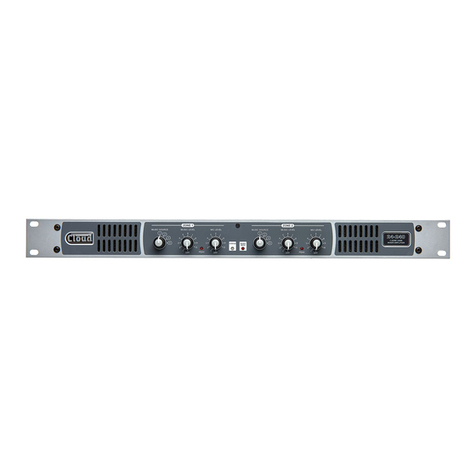
Cloud
Cloud 24 Series User manual
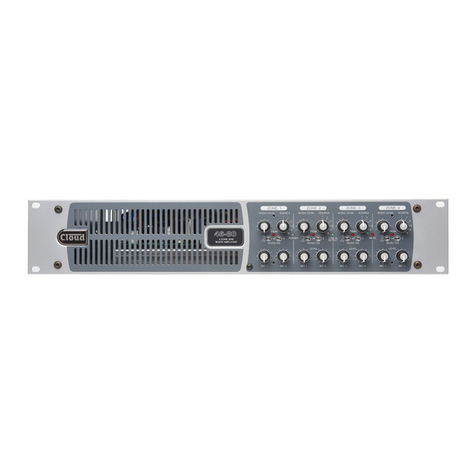
Cloud
Cloud 46-80 User manual
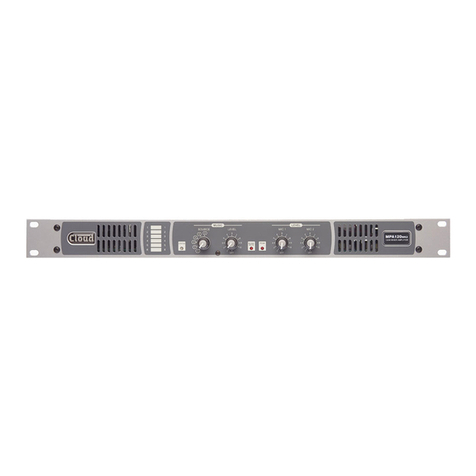
Cloud
Cloud MPA MK2 Series User manual

Cloud
Cloud MA80E User manual
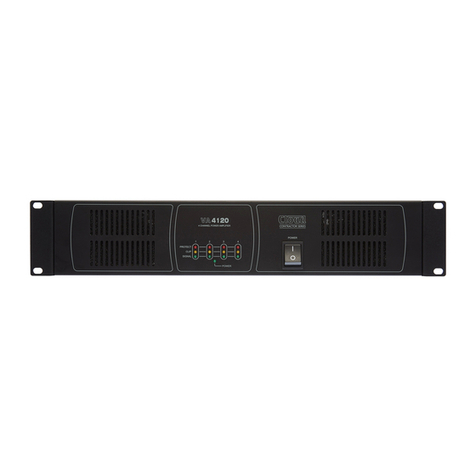
Cloud
Cloud CONTRACTOR VA Series User manual
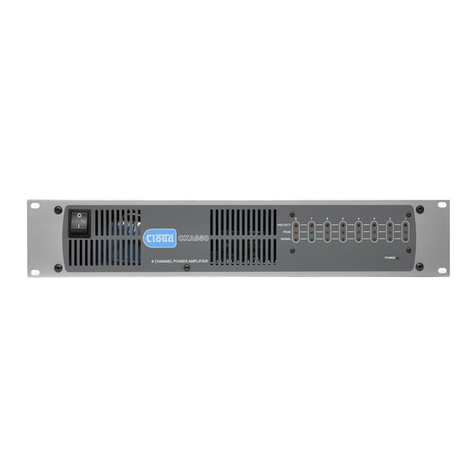
Cloud
Cloud CX-A850 Operation manual

Cloud
Cloud CXV225NA User manual

Cloud
Cloud 46 Series User manual
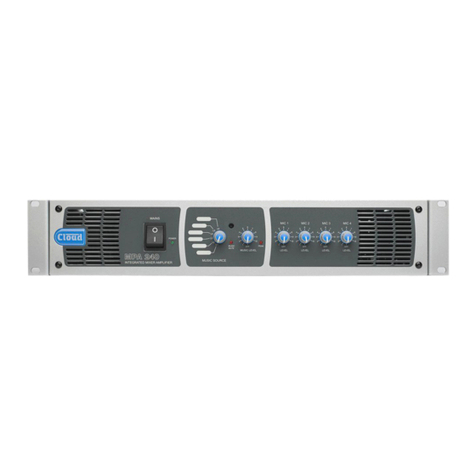
Cloud
Cloud MPA SERIES User manual
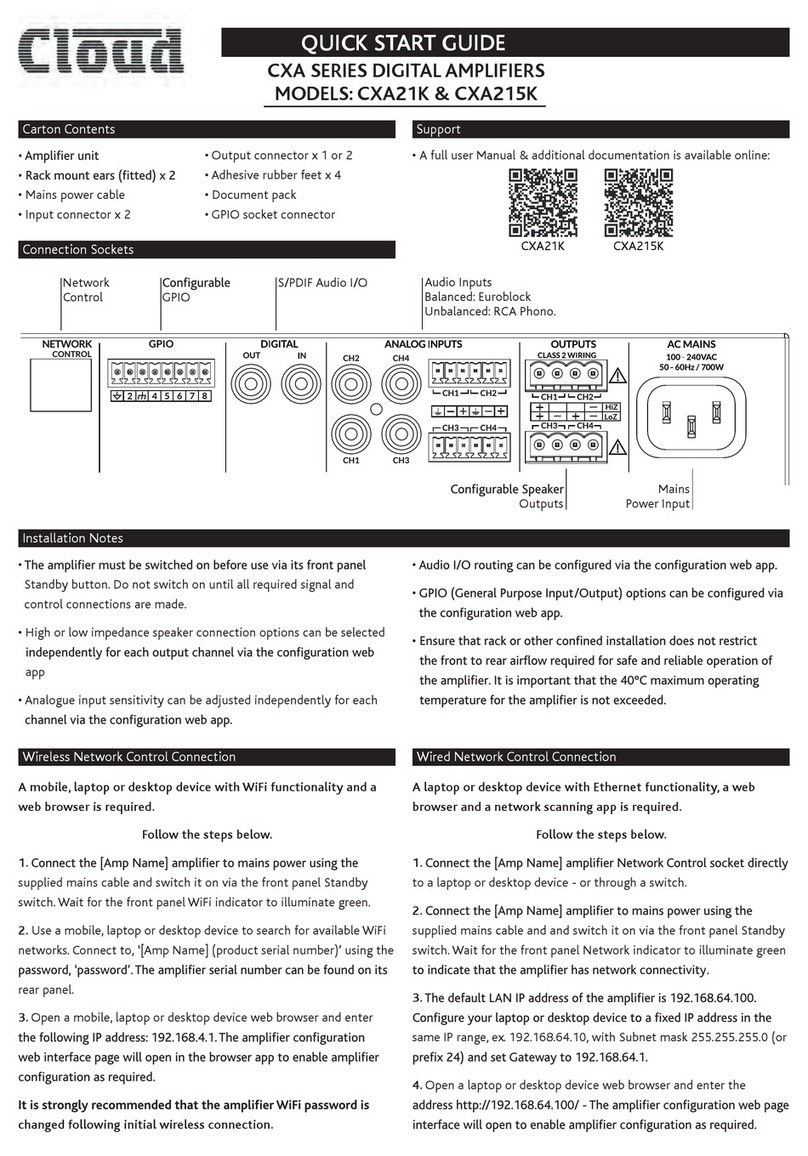
Cloud
Cloud CXA Series User manual
